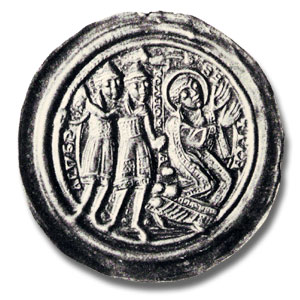EARLY ANTISEMITIC COIN
Although this discourse concentrates on medals, coins also have been used to disseminate antisemitic hatred. One of these, shown in figure 59, is considered to be the first antisemitic coin. It was issued by Bishop Ulrich I, who ruled in Halberstadt, then part of the Holy Roman Empire, late in the twelfth century. A silver pfennig, it was believed to be used for tax purposes rather than for ordinary commerce. The theme for his coin was of Biblical origin. Taken from the New Testament, he selected the story of the stoning of St. Stephen by Jews, an event which is believed to have taken place in the first century CE.
At the time of St. Stephens’s life, Jews did not wear cone-shaped hats, but during the twelfth century they were required by law to wear such hats so that they were clearly distinguishable from the rest of the citizenry. Although the coin was issued about 1000 years after the purported St. Stephen stoning, this imagery is repeated on the coin. It depicts two men wearing conical hats, with St. Stephen shown falling from the thrown rocks, a halo over his head, indicating his canonization. Based on their garb, there can be no mistaking the fact that Jews are the ones being shown doing the stoning.

Figure 59. Antisemitic Coin: Stoning of St Stephen
Silver pfennig, ca 25 mm, 12th century (Image courtesy of the American Israel Numismatic Association)
 |
 |
 |
 |
© 2000-2011 Jewish-American Hall of Fame © 2012-2015 American Numismatic Society All Rights Reserved by Benjamin Weiss